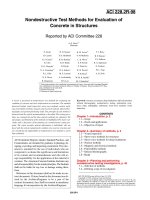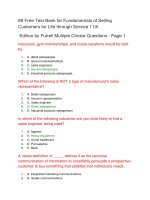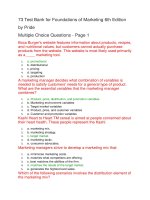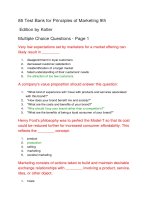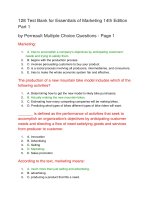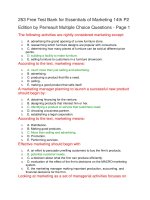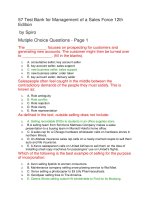ISO 289272:2009 Handheld portable power tools — Test methods for evaluation of vibration emission — Part 2: Wrenches, nutrunners and screwdrivers
Bạn đang xem bản rút gọn của tài liệu. Xem và tải ngay bản đầy đủ của tài liệu tại đây (1010.97 KB, 46 trang )
INTERNATIONAL ISO
STANDARD 28927-2
First edition
2009-12-15
Hand-held portable power tools — Test
methods for evaluation of vibration
emission —
Part 2:
Wrenches, nutrunners and screwdrivers
Machines à moteur portatives — Méthodes d'essai pour l'évaluation de
l'émission de vibrations —
Partie 2: Clés, boulonneuses et visseuses
Reference number
ISO 28927-2:2009(E)
© ISO 2009
ISO 28927-2:2009(E)
PDF disclaimer
This PDF file may contain embedded typefaces. In accordance with Adobe's licensing policy, this file may be printed or viewed but
shall not be edited unless the typefaces which are embedded are licensed to and installed on the computer performing the editing. In
downloading this file, parties accept therein the responsibility of not infringing Adobe's licensing policy. The ISO Central Secretariat
accepts no liability in this area.
Adobe is a trademark of Adobe Systems Incorporated.
Details of the software products used to create this PDF file can be found in the General Info relative to the file; the PDF-creation
parameters were optimized for printing. Every care has been taken to ensure that the file is suitable for use by ISO member bodies. In
the unlikely event that a problem relating to it is found, please inform the Central Secretariat at the address given below.
COPYRIGHT PROTECTED DOCUMENT
© ISO 2009
All rights reserved. Unless otherwise specified, no part of this publication may be reproduced or utilized in any form or by any means,
electronic or mechanical, including photocopying and microfilm, without permission in writing from either ISO at the address below or
ISO's member body in the country of the requester.
ISO copyright office
Case postale 56 • CH-1211 Geneva 20
Tel. + 41 22 749 01 11
Fax + 41 22 749 09 47
Web www.iso.org
Published in Switzerland
ii © ISO 2009 – All rights reserved
ISO 28927-2:2009(E)
Contents Page
Foreword ............................................................................................................................................................iv
Introduction ........................................................................................................................................................ vi
1 Scope ......................................................................................................................................................1
2 Normative references............................................................................................................................1
3 Terms, definitions and symbols ..........................................................................................................2
3.1 Terms and definitions ...........................................................................................................................2
3.2 Symbols..................................................................................................................................................3
4 Basic standards and vibration test codes ..........................................................................................3
5 Description of the family of machines ................................................................................................3
6 Characterization of vibration................................................................................................................7
6.1 Direction of measurement ....................................................................................................................7
6.2 Location of measurements...................................................................................................................7
6.3 Magnitude of vibration ........................................................................................................................13
6.4 Combination of vibration directions..................................................................................................13
7 Instrumentation requirements............................................................................................................13
7.1 General .................................................................................................................................................13
7.2 Mounting of transducers ....................................................................................................................13
7.3 Frequency weighting filter..................................................................................................................13
7.4 Integration time....................................................................................................................................13
7.5 Auxiliary equipment ............................................................................................................................14
7.6 Calibration ............................................................................................................................................14
8 Testing and operating conditions of the machinery........................................................................14
8.1 General .................................................................................................................................................14
8.2 Operating conditions ..........................................................................................................................15
8.3 Other quantities to be specified.........................................................................................................15
8.4 Attached equipment, work piece and task........................................................................................15
8.5 Operators..............................................................................................................................................18
9 Measurement procedure and validity................................................................................................19
9.1 Reported vibration values ..................................................................................................................19
9.2 Declaration and verification of the vibration emission value .........................................................19
10 Measurement report ............................................................................................................................20
Annex A (informative) Model test report for vibration emission of wrenches, nutrunners and
screwdrivers ........................................................................................................................................21
Annex B (normative) Determination of uncertainty ......................................................................................23
Annex C (normative) Brake devices — Assembly drawings and specification of parts ...........................26
Bibliography ...................................................................................................................................................... 39
© ISO 2009 – All rights reserved iii
ISO 28927-2:2009(E)
Foreword
ISO (the International Organization for Standardization) is a worldwide federation of national standards bodies
(ISO member bodies). The work of preparing International Standards is normally carried out through ISO
technical committees. Each member body interested in a subject for which a technical committee has been
established has the right to be represented on that committee. International organizations, governmental and
non-governmental, in liaison with ISO, also take part in the work. ISO collaborates closely with the
International Electrotechnical Commission (IEC) on all matters of electrotechnical standardization.
International Standards are drafted in accordance with the rules given in the ISO/IEC Directives, Part 2.
The main task of technical committees is to prepare International Standards. Draft International Standards
adopted by the technical committees are circulated to the member bodies for voting. Publication as an
International Standard requires approval by at least 75 % of the member bodies casting a vote.
Attention is drawn to the possibility that some of the elements of this document may be the subject of patent
rights. ISO shall not be held responsible for identifying any or all such patent rights.
ISO 28927-2 was prepared by Technical Committee ISO/TC 118, Compressors and pneumatic tools,
machines and equipment, Subcommittee SC 3, Pneumatic tools and machines.
This first edition of ISO 28927-2 cancels and replaces ISO 8662-7:1997, of which it constitutes a technical
revision. The most important changes are
⎯ vibration measurement in three axes and at both hand positions,
⎯ new transducer positions,
⎯ improved definition of transducer positions and orientation, and
⎯ all types of screwdrivers and nutrunners, excepting one-shot nutrunners, now covered.
ISO 29827 consists of the following parts, under the general title Hand-held portable power tools — Test
methods for evaluation of vibration emission:
⎯ Part 1: Angle and vertical grinders1)
⎯ Part 2: Wrenches, nutrunners and screwdrivers
⎯ Part 3: Polishers and rotary, orbital and random orbital sanders2)
⎯ Part 4: Straight grinders3)
1) Together with Part 4, replaces ISO 8662-4, Hand-held portable power tools — Measurement of vibrations at the
handle — Part 4: Grinders.
2) Replaces ISO 8662-8, Hand-held portable power tools — Measurement of vibrations at the handle — Part 8:
Polishers and rotary, orbital and random orbital sanders.
3) Together with Part 1, replaces ISO 8662-4, Hand-held portable power tools — Measurement of vibrations at the
handle — Part 4: Grinders.
iv © ISO 2009 – All rights reserved
ISO 28927-2:2009(E)
⎯ Part 5: Drills and impact drills4)
⎯ Part 6: Rammers5)
⎯ Part 7: Nibblers and shears6)
⎯ Part 8: Saws, polishing and filing machines with reciprocating action and small saws with oscillating or
rotating action7)
⎯ Part 9: Scaling hammers and needle scalers8)
⎯ Part 10: Percussive drills, hammers and breakers9)
⎯ Part 11: Stone hammers10)
4) Replaces ISO 8662-6, Hand-held portable power tools — Measurement of vibrations at the handle — Part 6: Impact
drills. Non-impacting drills now covered.
5) Replaces ISO 8662-9, Hand-held portable power tools — Measurement of vibrations at the handle — Part 9:
Rammers.
6) Replaces ISO 8662-10, Hand-held portable power tools — Measurement of vibrations at the handle — Part 10:
Nibblers and shears
7) Replaces ISO 8662-12, Hand-held portable power tools — Measurement of vibrations at the handle — Part 12: Saws
and files with reciprocating action and saws with oscillating or rotating action
8) Together with Part 11, replaces ISO 8662-14, Hand-held portable power tools — Measurement of vibrations at the
handle — Part 14: Stone-working tools and needle scalers.
9) Replaces ISO 8662-2, Hand-held portable power tools — Measurement of vibrations at the handle — Part 2: Chipping
hammers and riveting hammers, ISO 8662-3, Hand-held portable power tools — Measurement of vibrations at the
handle — Part 3: Rock drills and rotary hammers, and ISO 8662-5, Hand-held portable power tools — Measurement of
vibrations at the handle — Part 5: Pavement breakers and hammers for construction work. Chipping and riveting hammers,
rock drills and rotary hammers all covered.
10) Together with Part 9, replaces ISO 8662-14, Hand-held portable power tools — Measurement of vibrations at the
handle — Part 14: Stone-working tools and needle scalers.
© ISO 2009 – All rights reserved v
ISO 28927-2:2009(E)
Introduction
This document is a type-C standard as stated in ISO 12100.
When requirements of this type-C standard are different from those which are stated in type-A or -B standards,
the requirements of this type-C standard take precedence over the requirements of the other standards for
machines that have been designed and built according to the requirements of this type-C standard.
The vibration test codes for portable hand-held machines given in ISO 28927 are based on ISO 20643, which
gives general specifications for the measurement of the vibration emission of hand-held and hand-guided
machinery. ISO 28927 specifies the operation of the machines under type-test conditions and other
requirements for the performance of type tests. The structure/numbering of its clauses follows that of
ISO 20643.
The basic principle for transducer positioning first introduced in the EN 60745 series of European standards is
followed, representing a deviation from ISO 20643 for reasons of consistency. The transducers are primarily
positioned next to the hand in the area between the thumb and the index finger, where they give the least
disturbance to the operator gripping the machine.
It has been found that vibrations generated by wrenches and nutrunners during tightening and unfastening of
threaded fasteners vary considerably in typical use. For impact and impulse machines, this is largely due to
misalignment between the machine and the fastener, to worn sockets or to the use of universal joints and
angle heads. Owing to the very short tightening times in real use, the response times in the vibration
measurement system used also become critical for the measurement results.
In order to provide a method that gives good measurement reproducibility, this part of ISO 28927 adopts a
procedure for testing impact and impulse machines using a test device based on break blocks acting on the
outer diameter of a test socket, and a free running test for other machines. The procedures of ISO 5349 are
required whenever exposure at the workplace is to be assessed.
The values obtained are type-test values intended to be representative of the average of the upper quartile of
typical vibration magnitudes in real-world use of the machines. However, the actual magnitudes will vary
considerably from time to time and depend on many factors, including the operator, the task and the inserted
tool or consumable. The state of maintenance of the machine itself might also be of importance. Under real
working conditions the influences of the operator and process can be particularly important at low magnitudes.
It is therefore not recommended that emission values below 2,5 m/s2 be used for estimating the vibration
magnitude under real working conditions In such cases, 2,5 m/s2 is the recommended vibration magnitude for
estimating the machine vibration.
If accurate values for a specific work place are required, then measurements (according to ISO 5349) in that
work situation could be necessary. Vibration values measured in real working conditions can be either higher
or lower than the values obtained using this part of ISO 28927.
Higher vibration magnitudes can easily occur in real work situations, caused by either misalignment between
the machine and fastener, worn sockets or the use of universal joints or angle heads. The operator's hands
ought never to be in contact with rotating parts such as the sockets or the extensions used.
The vibration test codes given in ISO 28927 supersede those given in ISO 8662, whose parts have been
replaced by the corresponding parts of ISO 28927 (see Foreword).
NOTE ISO 8662-11, Hand-held portable power tools — Measurement of vibrations at the handle — Part 11: Fastener
driving tools, and ISO 8662-13, Hand-held portable power tools — Measurement of vibrations at the handle — Part 13:
Die grinders, could be replaced by future parts of ISO 28927.
vi © ISO 2009 – All rights reserved
INTERNATIONAL STANDARD ISO 28927-2:2009(E)
Hand-held portable power tools — Test methods for evaluation
of vibration emission —
Part 2:
Wrenches, nutrunners and screwdrivers
1 Scope
This part of ISO 28927 specifies a laboratory method for measuring hand-transmitted vibration emission at the
handles of hand-held power-driven wrenches, nutrunners and screwdrivers used for tightening and loosening
threaded fasteners. It is a type-test procedure for establishing the magnitude of vibration in the gripping areas
of a machine when operating at a specified load. The method has been tested for fastening tasks only. It is
intended that the results be used to compare different models of the same type of machine.
This part of ISO 28927 is applicable to hand-held machines (see Clause 5), driven pneumatically or by other
means, with impact or impulse action, of shut-off, ratchet or stall type, and of all designs — straight, pistol-grip,
angle or bow handle. It covers machines with 6,3 mm to 40 mm (1/4 in to 11/2 in) male or female drive output
shafts, as well as other geometries. It is not applicable to nutrunners designed to be used only in torque
reaction arms.
NOTE To avoid confusion with the terms “power tool” and “inserted tool”, machine is used for the former throughout
this document.
2 Normative references
The following referenced documents are indispensable for the application of this document. For dated
references, only the edition cited applies. For undated references, the latest edition of the referenced
document (including any amendments) applies.
ISO 691:2005, Assembly tools for screws and nuts — Wrench and socket openings — Tolerances for general
use
ISO 2787:1984, Rotary and percussive pneumatic tools — Performance tests
ISO 5349:2001 (all parts), Mechanical vibration — Measurement and evaluation of human exposure to hand-
transmitted vibration
ISO 5391:2003, Pneumatic tools and machines — Vocabulary
ISO 17066:2007, Hydraulic tools — Vocabulary
ISO 20643:2005, Mechanical vibration — Hand-held or hand guided machinery — Principles for evaluation of
vibration emission
EN 12096:1997, Mechanical vibration — Declaration and verification of vibration emission values
© ISO 2009 – All rights reserved 1
ISO 28927-2:2009(E)
3 Terms, definitions and symbols
For the purposes of this document, the terms and definitions given in ISO 5391, ISO 17066 and ISO 20643,
and the following terms, definitions and symbols, apply.
3.1 Terms and definitions
3.1.1
loading device
brake device
device used to obtain a stable rotational frequency of the output shaft of the machine and to absorb the output
energy of the machine
3.1.2
impact wrench
rotary machine fitted with a rotating or oscillating motor driving a hammer that periodically strikes an anvil to
tighten nuts and bolts without producing any considerable reaction torque on the machine
NOTE Adapted from ISO 5391:2003, definition 3.2.1.
3.1.3
ratchet wrench
angle drive wrench that progressively rotates a socket by means of a ratchet and pawl coupling
[ISO 5391:2003, definition 3.1.2.8]
3.1.4
screwdriver
rotary, reversible or non-reversible machine that drives a spindle fitted with a screwdriver bit
[ISO 5391:2003, definition 3.1.1]
NOTE Nutrunner or screwdriver can designate the same machine fitted with a socket or screwdriver bit, respectively.
3.1.5
nutrunner
rotary, reversible or non-reversible machine incorporating a socket adapter for the tightening of nuts and bolts
NOTE 1 Adapted from ISO 5391:2003, definition 3.1.2.
NOTE 2 Nutrunner or screwdriver can designate the same machine fitted with a socket or screwdriver bit, respectively.
3.1.6
automatic shut-off nutrunner
nutrunner where the setting of the tightening torque is achieved by shutting off the motor when the set torque
is achieved
NOTE Adapted from ISO 5391:2003, definition 3.1.2.5.
3.1.7
impulse nutrunner
impulse wrench
machine fitted with a motor that drives an hydraulic impulse mechanism for tightening threaded fasteners,
applying torque to a fastener in discontinuous increments through a hydraulic impulse unit
NOTE Adapted from ISO 5391:2003, definition 3.3.1.
2 © ISO 2009 – All rights reserved
ISO 28927-2:2009(E)
3.1.8
stall-type nutrunner
nutrunner whose tightening torque can only be set by air pressure adjustments
NOTE Adapted from ISO 5391:2003, definition 3.1.2.3.
3.2 Symbols
Symbol Description Unit
ahw m/s2
root-mean-square (r.m.s.) single-axis acceleration value of the frequency- m/s2
ahv weighted hand-transmitted vibration
vibration total value of frequency-weighted r.m.s. acceleration; root sum of m/s2
a hv squares of ahw values for the three measured axes of vibration
ah arithmetic mean value of ahv values of runs for one operator for one hand m/s2
position m/s2
a h
ahd arithmetic mean value of ahv values for all operators for one hand position m/s2
sn−1 arithmetic mean value of ah values for one hand position on several m/s2
σR machines m/s2
Cv declared vibration emission value
K standard deviation for a test series (for a sample, s) m/s2
standard deviation of reproducibility (for a population, σ)
coefficient of variation for a test series
uncertainty
4 Basic standards and vibration test codes
This part of ISO 28297 is based on the requirements of ISO 20643 and corresponds to its structure in respect
of clause subjects and numbering except for the annexes.
Annex A presents a model test report, Annex B the means for determining the uncertainty, K, and Annex C
specifies brake devices.
5 Description of the family of machines
This part of ISO 29827 applies to hand-held machines intended for tightening and loosening threaded
fasteners. It does not apply to one-shot type impact nutrunners, where a rotating mass is accelerated to a
given rotational speed and then connected to the bolt.
Figures 1 to 10 show examples of typical wrenches, nutrunners and screwdrivers covered by this part of
ISO 29827.
© ISO 2009 – All rights reserved 3
ISO 28927-2:2009(E)
Figure 1 — Impact wrench/impulse nutrunner with pistol grip
Figure 2 — Impact wrench/impulse nutrunner with pistol grip and support handle
Figure 3 — Impact wrench/impulse nutrunner with bow grip and bow-shaped support handle
4 © ISO 2009 – All rights reserved
ISO 28927-2:2009(E)
Figure 4 — Impact wrench/impulse nutrunner with bow grip and straight support handle
Figure 5 — Ratchet wrench
Figure 6 — Angle nutrunner
© ISO 2009 – All rights reserved 5
ISO 28927-2:2009(E)
Figure 7 — Straight screwdriver
Figure 8 — Screwdriver with support handle
6 © ISO 2009 – All rights reserved
ISO 28927-2:2009(E)
Figure 9 — Screwdriver with drill-type pistol grip
Figure 10 — Screwdriver with balanced pistol grip
6 Characterization of vibration
6.1 Direction of measurement
The vibration transmitted to the hand shall be measured and reported for three directions of an orthogonal
coordinate system. At each hand position, the vibration shall be measured simultaneously in the three
directions shown in Figures 11 to 20.
6.2 Location of measurements
Measurements shall be made at the gripping zones, where the operator normally holds the machine and
applies the feed force. For machines intended for one-handed operation, it is only necessary to measure at a
single point.
The prescribed transducer location shall be as close as possible to the hand between the thumb and index
finger. This shall apply to both hand positions, with the machine held as in normal operation. Whenever
possible, measurements shall be made at the prescribed locations.
© ISO 2009 – All rights reserved 7
ISO 28927-2:2009(E)
A secondary location is defined as being on the side of, and as close as possible to, the inner end of the
handle where the prescribed location is found. If the prescribed location of the transducer cannot be used, this
secondary location shall be used instead.
The prescribed or secondary location shall also be used on anti-vibration handles.
Figures 11 to 19 show the prescribed and secondary locations and measurement directions for the hand
positions normally used for the different types of machines in this family.
Impact and impulse tools with a mass less than 2 kg are normally operated using only one hand and therefore
only the hand position on the trigger handle need be measured and reported. Tools of a mass of 2 kg or more
are normally operated using both hands, and so measurements shall be made in two positions. For tools
without a side handle, the second hand position is on the front housing, or — if that is not possible — on the
motor housing (see Figure 11). For battery tools, the weight includes the standard battery.
Key
1 prescribed location
2 secondary location
Figure 11 — Measurement locations — Impact wrench/impulse nutrunner with pistol grip
Key
1 prescribed location
2 secondary location
Figure 12 — Measurement locations — Impact wrench/impulse nutrunner
with pistol grip and support handle
8 © ISO 2009 – All rights reserved
ISO 28927-2:2009(E)
Key
1 prescribed location
2 secondary location
Figure 13 — Measurement locations — Impact wrench/impulse nutrunner with bow grip and
bow shaped support handle
Key
1 prescribed location
2 secondary location
Figure 14 — Measurement locations — Impact wrench/impulse nutrunner with bow grip and
straight support handle
© ISO 2009 – All rights reserved 9
ISO 28927-2:2009(E)
Key
1 prescribed location
2 secondary location
Figure 15 — Measurement locations — Ratchet wrench
Key
1 prescribed location
2 secondary location
Figure 16 — Measurement locations — Angle nutrunner
10 © ISO 2009 – All rights reserved
ISO 28927-2:2009(E)
Key
1 prescribed location
2 secondary location
Figure 17 — Measurement locations — Straight screwdriver with support handle
Key
1 prescribed location
2 secondary location
Figure 18 — Measurement locations — Straight screwdriver
© ISO 2009 – All rights reserved 11
ISO 28927-2:2009(E)
Key
1 prescribed location
2 secondary location
Figure 19 — Measurement locations — Screwdriver with drill-type pistol grip
Key
1 prescribed location
2 secondary location
Figure 20 — Measurement locations — Screwdriver with balanced pistol grip
12 © ISO 2009 – All rights reserved
ISO 28927-2:2009(E)
6.3 Magnitude of vibration
The magnitude of vibration shall be in accordance with ISO 20643:2005, 6.3.
6.4 Combination of vibration directions
The vibration total value in accordance with ISO 20643:2005, 6.4, shall be reported for both hand positions as
applicable. It is acceptable to report and carry out tests on the hand position having the highest reading. The
vibration total value at that hand position shall be at least 30 % higher than the other. This result may be
obtained during a preliminary test carried out by a single operator during five test runs.
To obtain the vibration total value, ahv, for each test run, the results in each direction shall be combined using
Equation (1):
ahv = ahwx 2 + ahwy 2 + ahwz 2 (1)
7 Instrumentation requirements
7.1 General
The instrumentation shall be in accordance with ISO 20643:2005, 7.1.
7.2 Mounting of transducers
7.2.1 Specification of transducer
The specification of the transducer given in ISO 20643:2005, 7.2.1, applies.
The total mass of the transducers and mounting device shall be small enough, compared with that of the
machine, handle, etc., so as not to influence the measurement result.
This is particularly important for low-mass plastic handles (see ISO 5349-2).
7.2.2 Fastening of transducers
The transducer or mounting block used shall be rigidly attached to the surface of the handle.
If three single-axis transducers are used, these shall be attached to three sides of a suitable mounting block.
For the two axes aligned parallel to the vibrating surface, the measurement axes of the two transducers — or
the two transducer elements in a triaxial transducer — shall be a maximum of 10 mm from the surface.
It is strongly recommended that mechanical filters be used for measurements performed on impact wrenches.
7.3 Frequency weighting filter
Frequency-weighting shall be in accordance with ISO 5349-1.
7.4 Integration time
The integration time shall be in accordance with ISO 20643:2005, 7.4. The integration time for each test run
shall be at least 8 s, so as to be consistent with the duration of machine operation defined in 8.4.4. The
exception to this are impulse machines, which shall be run for at least 5 s, to avoid overheating of the impulse
mechanism.
© ISO 2009 – All rights reserved 13
ISO 28927-2:2009(E)
7.5 Auxiliary equipment
For pneumatic machines, the air pressure shall be measured using a pressure gauge with an accuracy equal
to or better than 0,1 bar11).
For hydraulic machines, the flow shall be measured using a flow meter with an accuracy equal to or better
than 0,25 l/min.
For electrical machines, the voltage shall be measured using a volt meter with accuracy equal to or better than
3 % of the actual value.
The rotational speed of nutrunners and screwdrivers without impact, impulse or ratchet mechanisms, tested
under no-load conditions, shall be measured and reported with accuracy better than 5 % of the actual value,
using either a tachometer or frequency analysis of the measured vibration signal. When a tachometer
transducer is placed on the machine, it should be small enough not to influence the vibration of the machine.
The blow frequency of machines tested in the brake shall be determined, using the signal from the vibration
transducer or other suitable means. The accuracy shall be better than ± 1 Hz.
7.6 Calibration
The specifications for calibration given in ISO 20643:2005, 7.6, apply.
8 Testing and operating conditions of the machinery
8.1 General
Measurements shall be carried out on new, properly serviced and lubricated machines. During testing, the
machines shall be equipped and held in a manner similar to that used when tightening and loosening threaded
fasteners. If, for some types of machines, a warming-up period is specified by the manufacturer, this shall be
undertaken prior to the start of the test.
Wrenches, nutrunners and screwdrivers with an impact or impulse mechanism shall be measured while
operating in right-hand rotation on the loading device. It is permissible to operate the wrench, nutrunner or
screwdriver in left-hand rotation in cases where shut-off mechanisms, etc. make continuous operation in
right-hand rotation impossible.
Nutrunners and screwdrivers without an impact or impulse mechanism, as well as ratchet wrenches, shall be
measured while operating in right-hand rotation under no-load conditions. During testing, the machines shall
be equipped with a socket or toolbit of standard type with a size typical for the machine tested.
Machines intended for one-handed operation shall be held using only one hand during testing. Measurements
shall be made in one location only and for the hand position used. During measurement, a support handle
shall not be mounted.
During testing, the energy supply to the machine shall be at rated conditions, as specified by the manufacturer.
The operation shall be stable.
11) 1 bar = 0,1 MPa = 0,1 N/mm2 = 105 N/m2. © ISO 2009 – All rights reserved
14
